If the key word of the mobile phone in 2020 is “5G” and the smart home is “IoT”, then What I have to mention in TV is “8K”.
I wonder if you have found that whether it is a domestic or foreign TV manufacturer, they have been since last year Gradually make products high-definition and intelligent.

For picture quality, these TVs offer resolutions up to 8K, even if the source is less than 8K They can also improve picture quality through post-optimization. After the communication companies such as Huawei and Xiaomi entered the TV market, the competition between Internet TV and traditional TV manufacturers has also extended from picture quality to intelligent interaction. TV is no longer a device that simply plays video. It has been given a new definition, called ” Home Smart Terminal. ”

On this basis, in addition to picture quality among TV manufacturers in recent years, The system consists of content lineup and smart functions. Skyworth launched the Swaiot smart system at its autumn event last August, which is based on the TV platform to lay out a large-screen AIoT ecosystem.
On the eve of this year’s CES, Skyworth released three new TVs, Q91 and W81 / W81 Pro, Open the curtain of 8K smart TV this year.
Skyworth: Our 8K is different
Skyworth TVs are currently divided into Q / W / S / G four series, of which Q and W series are the two high-end product lines that Skyworth pushed for this year. The Q91 released this time is Skyworth ’s highest-configured LED LCD TV. It has a 75-inch 8K wide-angle IPS screen on the panel configuration and supports video playback up to 120FPS.
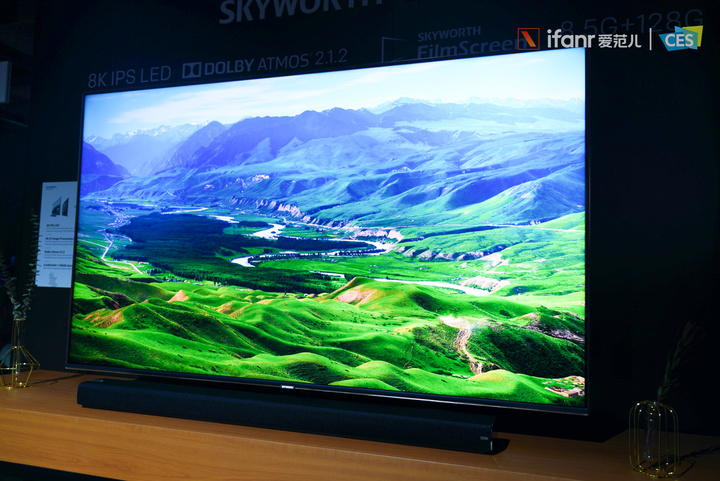
▲ Skyworth Q91 8K 120FPS TV
Introducing Skyworth, what Q91 will bring to viewers is the end-to-end experience of 8K video, so The TV uses a custom SoC and AI picture quality engine. Therefore, even in the case of non 8K video sources, the AI image quality engine can adjust the image quality and color through hardware decoding and software interpolation.
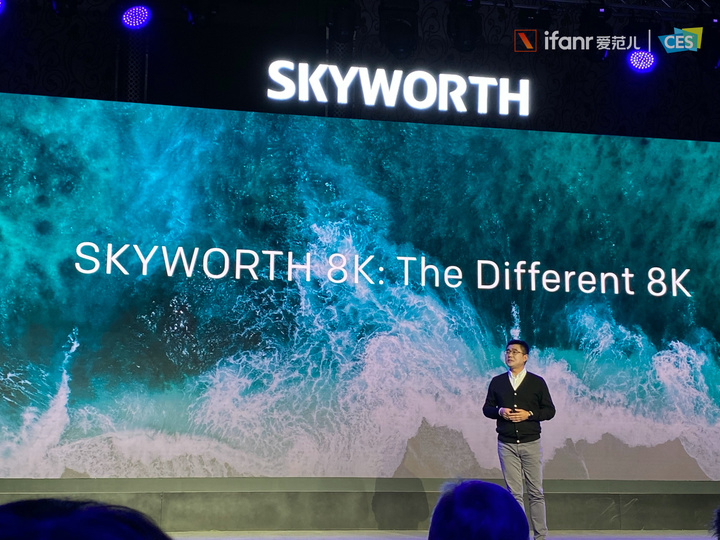
The functions of the AI image quality engine in Q91 are mainly divided into three areas:
- First, based on Skyworth’s own 8K impact database, AI automatically compensates the details of the picture to improve the clarity of the picture;
- Second is the frame rate compensation for dynamic pictures through MEMC technology, which improves the picture from 60FPS to 120FPS; < / li>
- Finally, 8K content is specially processed with the help of APU and NPU chips, so as to adjust the sharpness and color calibration of the image quality in real time.
In order to allow the TV to have sufficient resources to improve the picture quality content, Skyworth has set 8.5GB of storage and 128GB of storage space for the Q91. In addition, the SoC chip has also been greatly improved in processing and transmission performance.
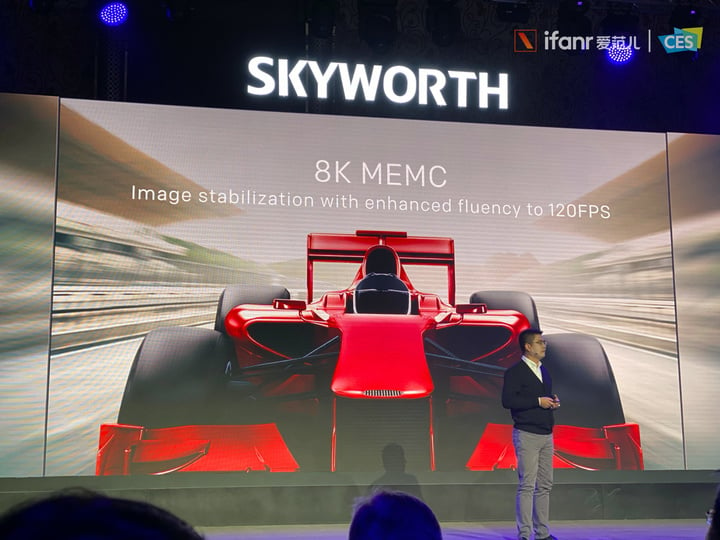
In design, Q91 continues to use Skyworth’s floating screen design, and the rear rear shell uses a screwless integrated sticker 合 结构。 Structure.
At this press conference, Skyworth exhibited the gentleman blue color Q91, which is a bit biased Navy blue tones. Skyworth said that in addition to this color matching is more stable, but also noble and elegant feeling.
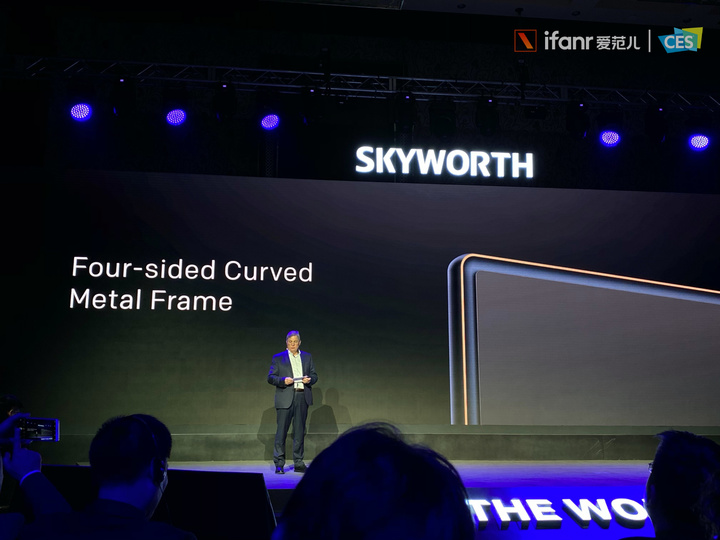
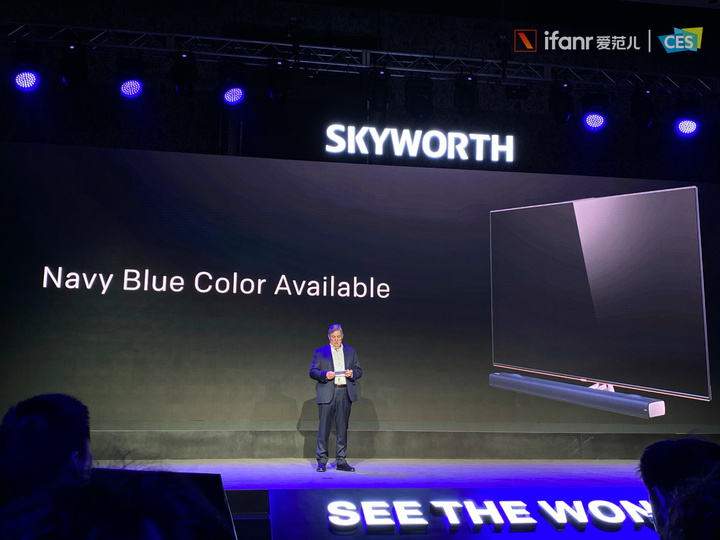
Q91 is equipped with Skyworth ’s second-generation lifting AI camera, based on thisIn addition to basic functions such as scene recognition, face recognition, and photography, the TV also supports functions such as motion recognition (myShape) and somatosensory games.
Skyworth said that the second-generation camera system uses Sony F1.8 CMOS, even in the There can also be enough ambient light to take photos and videos under low light conditions.
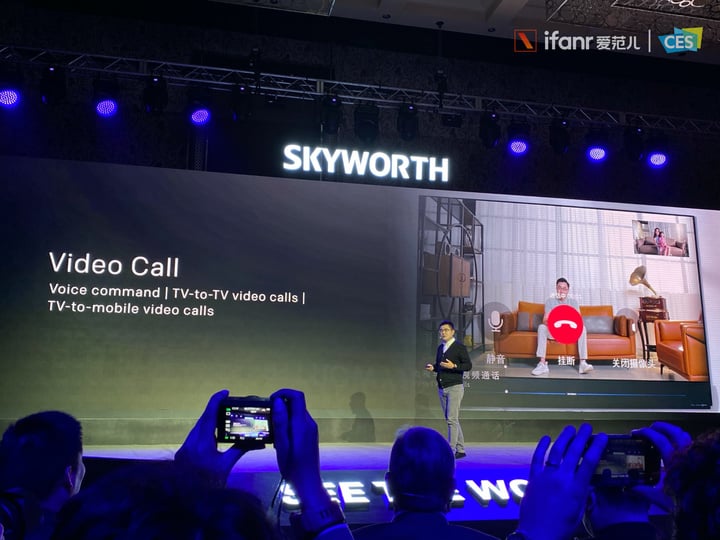
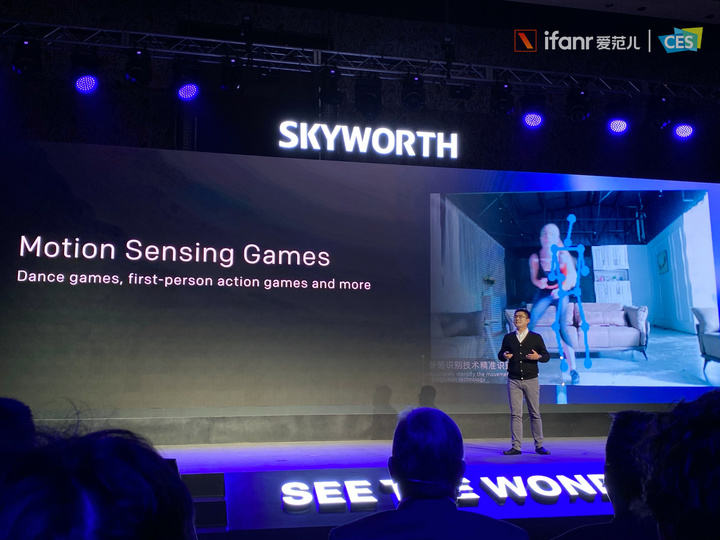
In the audio-visual system, the hardware of Q91 continues to adopt the “Magic Sky Channel” design, and the sound from The loudspeaker is sent upwards, then reflects into the human ear through the surrounding wall, which then brings the feeling of surround sound.
The TV also supports Dolby 2.1.2 surround sound technology to improve the sound quality of the TV.
W81 series, Skyworth’s first OBM TV
“Design” can be said to be the focus of this W81 series.
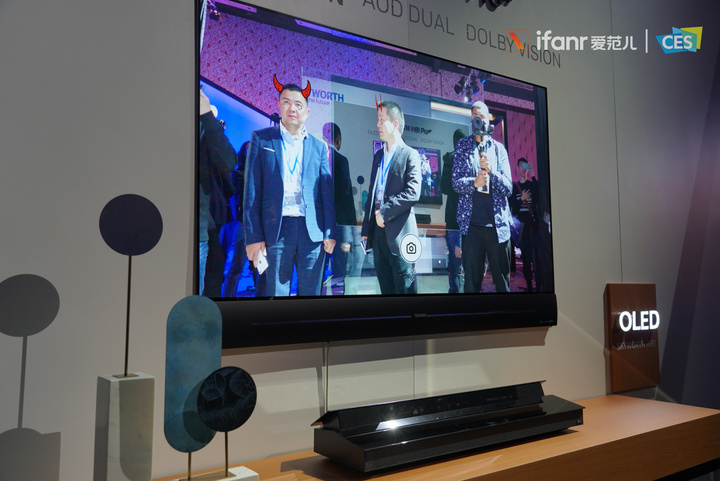
This TV still adopts the split design of the display + the host, but Skyworth carried out on the W81 series In terms of design innovation, on the one hand, it is only a 4.6 mm screen with the same thickness as a passport. As can be seen from the figure below, it can fit against the wall without leaving a gap. On the other hand, the lower host sub-screen uses a pop-up design. This sub-screen is a 21-inch bar-shaped OLED screen. Like the main screen above, this screen can also support AOD display.
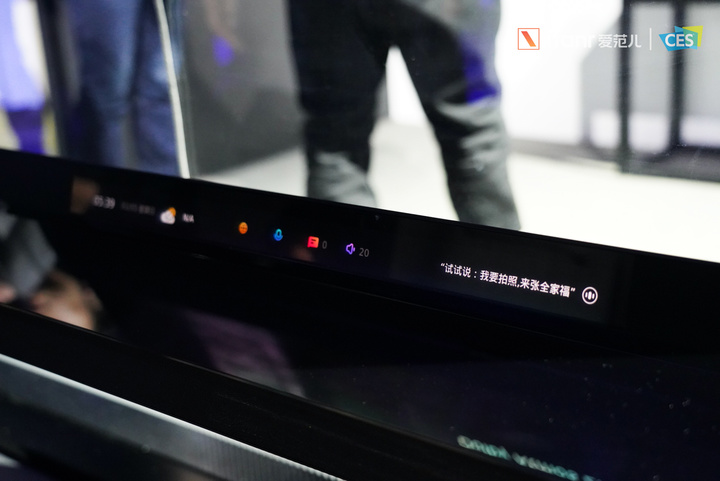
On the screen configuration, Skyworth currently provides a 65-inch specification for the W81 series (there will be a 75-inch version later), and supports 120Hz refresh rate, so the TV can also Use the game console as a gaming screen.
It is worth noting that the 120Hz and 120FPS mentioned here are two different things. The former is a 120Hz refresh rate display on the panel hardware, while 120FPS goes deeper into the content source and increases the number of content frames from 60FPS to 120FPS.
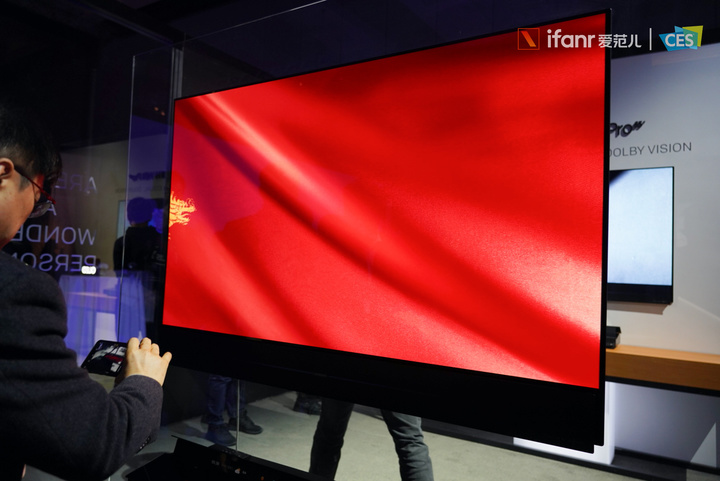
▲ Geek Link’s invisible fiber optic cable is on the left side of the screen
The screen and the host are connected by a stealth optical cable called Geek Link. This optical cable integrates content input, output and power transmission. Skyworth introduced that the design of the stealth optical cable can avoid the messy wires in the past. While improving the beauty of the product, it is also easy to organize daily.
Below the screen is the Skyworth Logo of Skyworth. Do n’t assume that this raised design is the designer ’s hand. Misoperation, in fact, this Logo is a slider with a 12-megapixel camera inside. When using the camera, the slider will open 2 cm. Exit the camera function and the slider will automatically close.
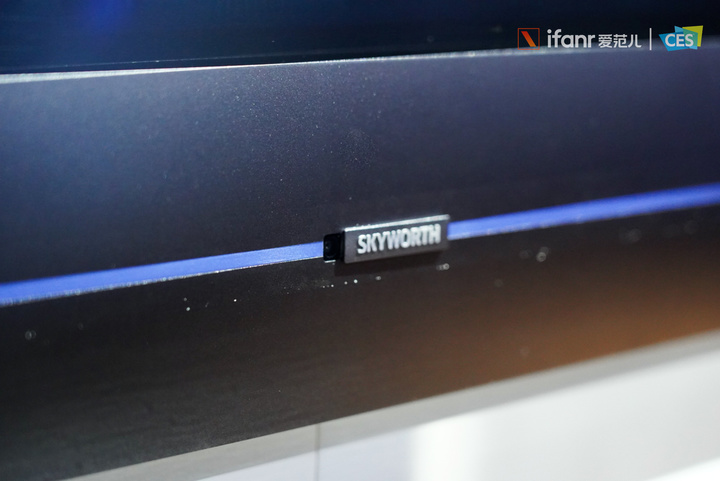
But compared to the design on the screen, I personally prefer the host below. This host uses a dual-material design of glass and metal. The upper part of the glass panel will rise and fall with the TV switch. In a dark light scene, the content in the screen will be reflected by the side glass panel, which will have a wonderful visual view.sense.
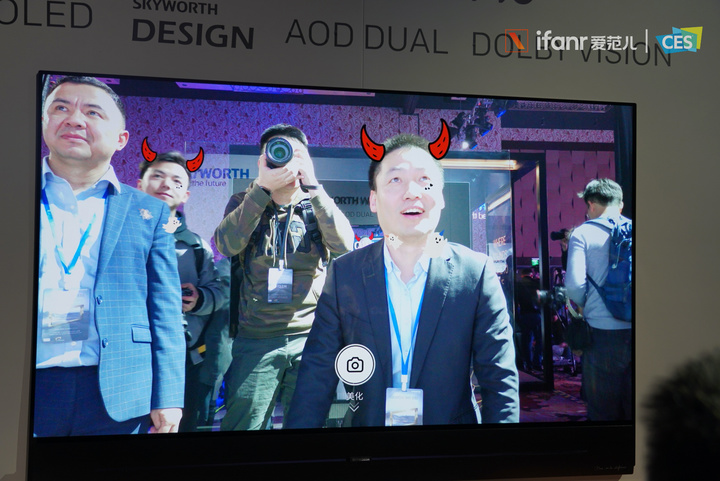
In addition, the W81 Pro’s main unit also integrates “Magic Sky Sound Field” and Dolby Atmos There are two upward sound units. Like Q91, it can bring surround sound effect by reflecting sound on the wall.
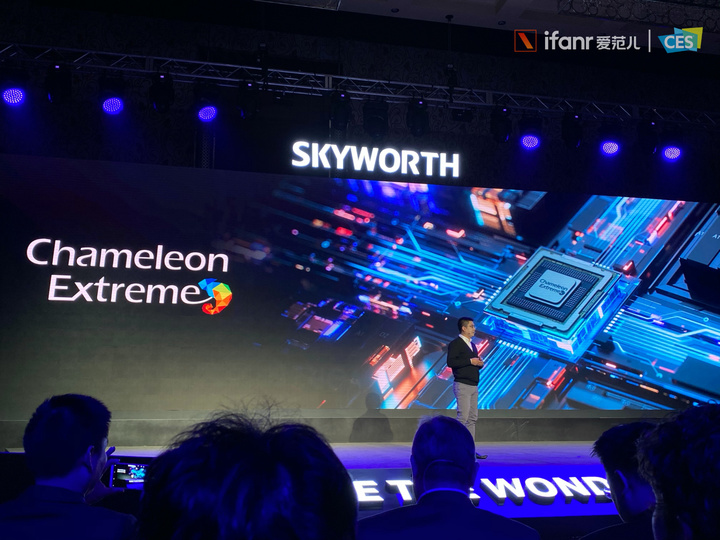
In terms of image optimization, the W81 series is equipped with a chameleon AI image quality chip, based on Skyworth image quality Adjusting experience, this chip can simultaneously evolve the picture color, contrast, sharpness, and dynamic picture, thereby improving the image quality and improving the image quality performance in all directions.
In addition to TV, Skyworth wants to do more
After introducing three new products, Skyworth announced Q91 and W81 / W81 Pro for sale in China Price:
- Q91 75 inches: 39999 yuan
- W81 65 inches: 24,999 yuan
- W81 Pro 65-inch: 29,999 yuan
Three TVs will be available for pre-sale on January 6, Beijing time, and will be officially released on January 20.

The three new TVs released by Skyworth mainly continue to follow the high-end line, in W and Q two Under the background that each series sold well last year, Skyworth needs to open a gap with friends and merchants through more diversified designs this year.
So, the 8K 120FPS Q91 and Wallpaper-designed W81 series came into being, becoming Skyworth in 2020 The first answer to the market.
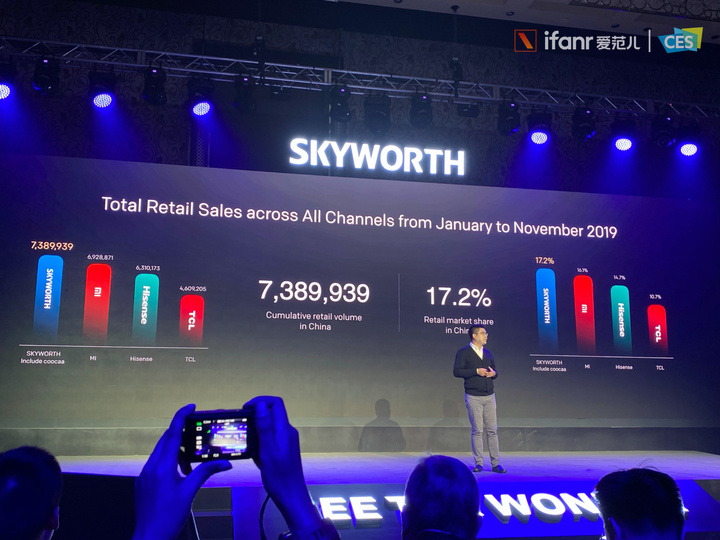
▲ Skyworth’s sales results from January to November 2019 are ahead of Xiaomi, Hisense, and TCL
Of course, with the new products released this time, we can also see Skyworth’s manufacturing and brand capabilities.
First, the 8K 120FPS display specification of Q91 is not only a breakthrough on the display panel, but also software Considerations for display technology and hardware configuration. Since most of the film and television content itself is not output in 8K or 120FPS format, the TV needs to process in real time through the SoC and AI image quality engine to supplement distortion details, adjust picture sharpness and color contrast, and finally output an optimized 8K picture.

This may seem simple, but it actually requires long-term image quality optimization and accumulation to give AI Provide resource support in real time later.
At the same time, the SoC will also compensate the frame rate of the content through MEMC, and the 60FPS screen Insert frames in real time and enhance the picture to 120FPS output. Skyworth introduced that they have cooperated with partners such as 4K Garden and Octaval on 8K content in video content to enrich the TV’s high-definition content lineup.

Overall, whether it is the Q91 or W81 series, these three new products are in design and configuration It shows the uniqueness of Skyworth in TV manufacturing. From the perspective of pure TV products, these new products are also high-end in the same category. However, what Skyworth has to do is not just TV. In a deeper perspective, what Skyworth has to do is a smart device ecosystem based on the Swaiot system. The equipment included here includes Skyworth’s refrigerators, air conditioners, washing machines and other white and black electricity. The TV is actually the main control of the whole house’s home appliances. Users can control the Skyworth home appliances based on this big screen.
As I said at the beginning of this article, in the development trend of smart home appliances, the TV’s function has exceeded the past What we know about television.
Swaiot Center is the ecological center of Skyworth’s large-screen AIoT, and it is also Skyworth’s new definition of TV.
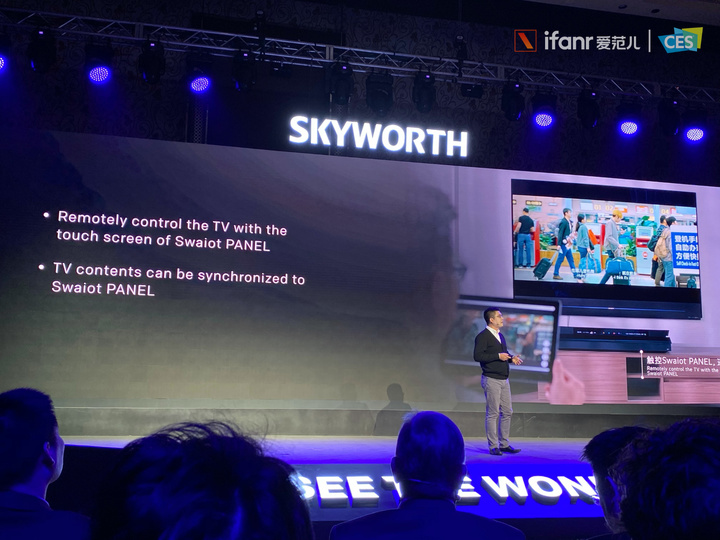
▲ Skyworth Swaiot PANEL is the control panel for all household appliances in the future
The Swaiot PANEL in the W81 series can be said to be Skyworth’s innovation in TV control, and it can be said to be Attempt at AIoT. This small screen changes the operation of the traditional TV, and applies the “remote control” function to other home appliances, which reduces the screen configuration of each home appliance and reduces costs, and avoids different smart home appliance protocols, unified integration into Within a control protocol.
According to Skyworth’s activities in August last year, Midea, JD.com, and Huawei have reached an ecology with Skyworth Cooperation, the equipment of these manufacturers can supplement the vacancies of Skyworth’s equipment in white and black electricity, and at the same time realize the interconnection of equipment. Under the same protocol, the role of Swaiot PANEL is not just a TV remote control, but a universal controller for these devices .
Compared with new TV and IoT product manufacturers such as Xiaomi and Glory, Skyworth’s advantages as a traditional home appliance company are mainly There are two aspects. On the one hand, Skyworth itself has a more solid foundation for TV tuning and optimization, and it already has a fairly mature system in TV manufacturing and supply cooperation; on the other hand, Skyworth already has a relatively mature layout of home appliances and develops AIoT. It already has a first-mover advantage in peripheral equipment. However, it is clear that Skyworth does not want to develop only one of the above-mentioned ones, but to capture the advantages of picture quality and intelligence.

▲ Skyworth Q91 8K 120FPS TV
Introducing Skyworth, what Q91 will bring to viewers is the end-to-end experience of 8K video, so The TV uses a custom SoC and AI picture quality engine. Therefore, even in the case of non 8K video sources, the AI image quality engine can adjust the image quality and color through hardware decoding and software interpolation.

The functions of the AI image quality engine in Q91 are mainly divided into three areas:
- First, based on Skyworth’s own 8K impact database, AI automatically compensates the details of the picture to improve the clarity of the picture;
- Second is the frame rate compensation for dynamic pictures through MEMC technology, which improves the picture from 60FPS to 120FPS; < / li>
- Finally, 8K content is specially processed with the help of APU and NPU chips, so as to adjust the sharpness and color calibration of the image quality in real time.
In order to allow the TV to have sufficient resources to improve the picture quality content, Skyworth has set 8.5GB of storage and 128GB of storage space for the Q91. In addition, the SoC chip has also been greatly improved in processing and transmission performance.

In design, Q91 continues to use Skyworth’s floating screen design, and the rear rear shell uses a screwless integrated sticker 合 结构。 Structure.
At this press conference, Skyworth exhibited the gentleman blue color Q91, which is a bit biased Navy blue tones. Skyworth said that in addition to this color matching is more stable, but also noble and elegant feeling.


Q91 is equipped with Skyworth ’s second-generation lifting AI camera, based on thisIn addition to basic functions such as scene recognition, face recognition, and photography, the TV also supports functions such as motion recognition (myShape) and somatosensory games.
Skyworth said that the second-generation camera system uses Sony F1.8 CMOS, even in the There can also be enough ambient light to take photos and videos under low light conditions.


In the audio-visual system, the hardware of Q91 continues to adopt the “Magic Sky Channel” design, and the sound from The loudspeaker is sent upwards, then reflects into the human ear through the surrounding wall, which then brings the feeling of surround sound.
The TV also supports Dolby 2.1.2 surround sound technology to improve the sound quality of the TV.
W81 series, Skyworth’s first OBM TV
“Design” can be said to be the focus of this W81 series.

This TV still adopts the split design of the display + the host, but Skyworth carried out on the W81 series In terms of design innovation, on the one hand, it is only a 4.6 mm screen with the same thickness as a passport. As can be seen from the figure below, it can fit against the wall without leaving a gap. On the other hand, the lower host sub-screen uses a pop-up design. This sub-screen is a 21-inch bar-shaped OLED screen. Like the main screen above, this screen can also support AOD display.

On the screen configuration, Skyworth currently provides a 65-inch specification for the W81 series (there will be a 75-inch version later), and supports 120Hz refresh rate, so the TV can also Use the game console as a gaming screen.
It is worth noting that the 120Hz and 120FPS mentioned here are two different things. The former is a 120Hz refresh rate display on the panel hardware, while 120FPS goes deeper into the content source and increases the number of content frames from 60FPS to 120FPS.

▲ Geek Link’s invisible fiber optic cable is on the left side of the screen
The screen and the host are connected by a stealth optical cable called Geek Link. This optical cable integrates content input, output and power transmission. Skyworth introduced that the design of the stealth optical cable can avoid the messy wires in the past. While improving the beauty of the product, it is also easy to organize daily.
Below the screen is the Skyworth Logo of Skyworth. Do n’t assume that this raised design is the designer ’s hand. Misoperation, in fact, this Logo is a slider with a 12-megapixel camera inside. When using the camera, the slider will open 2 cm. Exit the camera function and the slider will automatically close.

But compared to the design on the screen, I personally prefer the host below. This host uses a dual-material design of glass and metal. The upper part of the glass panel will rise and fall with the TV switch. In a dark light scene, the content in the screen will be reflected by the side glass panel, which will have a wonderful visual view.sense.

In addition, the W81 Pro’s main unit also integrates “Magic Sky Sound Field” and Dolby Atmos There are two upward sound units. Like Q91, it can bring surround sound effect by reflecting sound on the wall.

In terms of image optimization, the W81 series is equipped with a chameleon AI image quality chip, based on Skyworth image quality Adjusting experience, this chip can simultaneously evolve the picture color, contrast, sharpness, and dynamic picture, thereby improving the image quality and improving the image quality performance in all directions.
In addition to TV, Skyworth wants to do more
After introducing three new products, Skyworth announced Q91 and W81 / W81 Pro for sale in China Price:
- Q91 75 inches: 39999 yuan
- W81 65 inches: 24,999 yuan
- W81 Pro 65-inch: 29,999 yuan
Three TVs will be available for pre-sale on January 6, Beijing time, and will be officially released on January 20.

The three new TVs released by Skyworth mainly continue to follow the high-end line, in W and Q two Under the background that each series sold well last year, Skyworth needs to open a gap with friends and merchants through more diversified designs this year.
So, the 8K 120FPS Q91 and Wallpaper-designed W81 series came into being, becoming Skyworth in 2020 The first answer to the market.

▲ Skyworth’s sales results from January to November 2019 are ahead of Xiaomi, Hisense, and TCL
Of course, with the new products released this time, we can also see Skyworth’s manufacturing and brand capabilities.
First, the 8K 120FPS display specification of Q91 is not only a breakthrough on the display panel, but also software Considerations for display technology and hardware configuration. Since most of the film and television content itself is not output in 8K or 120FPS format, the TV needs to process in real time through the SoC and AI image quality engine to supplement distortion details, adjust picture sharpness and color contrast, and finally output an optimized 8K picture.

This may seem simple, but it actually requires long-term image quality optimization and accumulation to give AI Provide resource support in real time later.
At the same time, the SoC will also compensate the frame rate of the content through MEMC, and the 60FPS screen Insert frames in real time and enhance the picture to 120FPS output. Skyworth introduced that they have cooperated with partners such as 4K Garden and Octaval on 8K content in video content to enrich the TV’s high-definition content lineup.

Overall, whether it is the Q91 or W81 series, these three new products are in design and configuration It shows the uniqueness of Skyworth in TV manufacturing. From the perspective of pure TV products, these new products are also high-end in the same category. However, what Skyworth has to do is not just TV. In a deeper perspective, what Skyworth has to do is a smart device ecosystem based on the Swaiot system. The equipment included here includes Skyworth’s refrigerators, air conditioners, washing machines and other white and black electricity. The TV is actually the main control of the whole house’s home appliances. Users can control the Skyworth home appliances based on this big screen.
As I said at the beginning of this article, in the development trend of smart home appliances, the TV’s function has exceeded the past What we know about television.
Swaiot Center is the ecological center of Skyworth’s large-screen AIoT, and it is also Skyworth’s new definition of TV.

▲ Skyworth Swaiot PANEL is the control panel for all household appliances in the future
The Swaiot PANEL in the W81 series can be said to be Skyworth’s innovation in TV control, and it can be said to be Attempt at AIoT. This small screen changes the operation of the traditional TV, and applies the “remote control” function to other home appliances, which reduces the screen configuration of each home appliance and reduces costs, and avoids different smart home appliance protocols, unified integration into Within a control protocol.
According to Skyworth’s activities in August last year, Midea, JD.com, and Huawei have reached an ecology with Skyworth Cooperation, the equipment of these manufacturers can supplement the vacancies of Skyworth’s equipment in white and black electricity, and at the same time realize the interconnection of equipment. Under the same protocol, the role of Swaiot PANEL is not just a TV remote control, but a universal controller for these devices .
Compared with new TV and IoT product manufacturers such as Xiaomi and Glory, Skyworth’s advantages as a traditional home appliance company are mainly There are two aspects. On the one hand, Skyworth itself has a more solid foundation for TV tuning and optimization, and it already has a fairly mature system in TV manufacturing and supply cooperation; on the other hand, Skyworth already has a relatively mature layout of home appliances and develops AIoT. It already has a first-mover advantage in peripheral equipment. However, it is clear that Skyworth does not want to develop only one of the above-mentioned ones, but to capture the advantages of picture quality and intelligence.
- W81 65 inches: 24,999 yuan
- Second is the frame rate compensation for dynamic pictures through MEMC technology, which improves the picture from 60FPS to 120FPS; < / li>